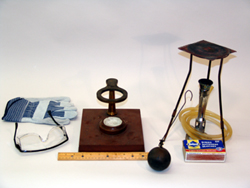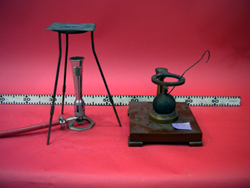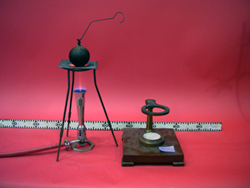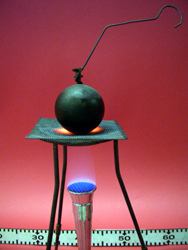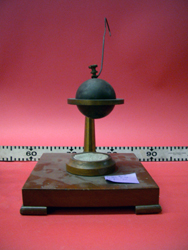|
Size: 1956
Comment:
|
← Revision 19 as of 2018-07-18 19:07:13 ⇥
Size: 4182
Comment:
|
| Deletions are marked like this. | Additions are marked like this. |
| Line 2: | Line 2: |
| = Large Ball and Ring Stand , 4A30.20 = | ||<30% style=""text-align:center" ">[[PiraScheme#Thermodynamics|Table of Thermodynamics Demonstration]] ||<30% style=""text-align:center" ">[[TDEquipmentList|Thermodynamics Equipment List]] ||<30% style=""text-align:center" ">[[Demonstrations|Lecture Demonstrations]] || = Large Ball and Ring Stand, 4A30.20 = '''Topic and Concept:''' . Thermal Properties of Matter, [[ThermalProperties#SolidExpansion|4A30. Solid Expansion]] '''pira200 Listed''' |
| Line 5: | Line 13: |
| Line 6: | Line 15: |
| * '''Bay:''' (A3) * '''Shelf:''' #1 |
* '''Bay:''' (A3)? * '''Shelf:''' #1? |
| Line 9: | Line 18: |
| attachment:4A30-20_01.jpg | {{attachment:BallStand04-400.jpg}} |
| Line 13: | Line 22: |
| This demonstration has a ball and ring with stand. It demonstrates the thermal expansion of the material by heating the ball. ||<:style="width: 60%" :40%>'''Equipment'''||<:30%>'''Location'''||<:25%>'''ID Number'''|| |
This demonstration has a ball and ring with stand. It demonstrates the thermal expansion of the material by heating the ball. ||<40% style=""text-align:center" ">'''Equipment''' ||<30% style=""text-align:center" ">'''Location''' ||<25% style=""text-align:center" ">'''ID Number''' || |
| Line 16: | Line 25: |
| ||A ring with stand and a ball with hanger||[:ThermoCabinetBayA3: TD, A3, Shelf #1]||<:> 4A30.20 || ||Burner with an iron ring tripod and wire net screen||location||<:> NA || ||An iron ring tripod and a screen||location||<:> NA || ||Safety grove and glasses||location||<:> NA || |
||A ring with stand and a ball with hanger ||[[ThermoCabinetBayA3|TD, A3, Shelf #1]] ||<style=""text-align:center"">4A30.20 || ||Burner with an iron ring tripod and wire net screen ||location ||<style=""text-align:center"">NA || ||An iron ring tripod and a screen ||location ||<style=""text-align:center"">NA || ||Safety grove and glasses ||location ||<style=""text-align:center"">NA || ||[[RedWhiteGasCart|Red and white gas carts]] ||Rooms 2103, 2241, (and 2223 upon request) || || |
| Line 22: | Line 32: |
| '''Setup:''' | |
| Line 24: | Line 33: |
| 1. Make sure that you have all apparatus in above table. 1. Install the burner gas tube with the gas source. 1. Make sure that you have the gas switch off and in the right pressure that you want before you turn it on. |
'''''Important Setup Notes:''''' * This demonstration requires a supply of methane gas usually provided by the [[RedWhiteGasCart|red and white gas carts]] found in rooms 2103, 2241, (and 2223 upon request). '''Setup and Procedure:''' 1. To light the burner, connect the attached gas hose to the gas out (red panel) on the [[RedWhiteGasCart|red and white gas cart]]. 1. Open the gas valve. 1. Light a match and bring it near the top of the burner. 1. The flame will ignite the gas. Adjust the flame height accordingly by adjusting the valve. 1. Show that the ball can get through the ring. 1. Put the lit burner beneath the tall ring stand with the screen on the top. 1. Lower the ball onto the screen using the attached hook. It will take about a minute for the ball to heat up enough to not fit through the ring 1. Take the ball off the stand and try to lower the ball through the ring. 1. If the ball fits through the ring, repeat steps 7 & 8. Otherwise, let the ball rest on the ring. As it cools, it will eventually shrink enough to drop through the ring. |
| Line 29: | Line 51: |
| 1. Use caution with the burner. 1. Wear safety glasses and grove for your safety. |
* Always use the gloves and safety glasses throughout this demonstration. * Beware of the heated plate - contact with skin could cause severe burns! '''Discussion:''' When the ball is heated, its dimensions increase while maintaining their relative proportions. Heating causes the molecular bonds to lengthen, which causes the material to expand. This is considered a 2D expansion since the quantity of importance for the ball to fit through the ring is the cross sectional area. The expansion can be described by ΔA/A = α,,A,,*ΔT = α,,L,,^2^*ΔT where A is the area at temperature T,,i,,, ΔA is the change in area when the material is at temperature T,,f,,, ΔT is T,,f,, - T,,i,,, and α is the coefficient of thermal expansion which depends on the material. See references below for more information. || {{attachment:4A30-20_01a.jpg}} || {{attachment:4A30-20_02a.jpg}} || {{attachment:BallStand03-250.jpg}} || {{attachment:BallStand04-250.jpg}} || || {{attachment:BallStand05-250.jpg}} || {{attachment:BallStand06-250.jpg}} || |
| Line 33: | Line 62: |
| '''Demonstration:''' | |
| Line 35: | Line 63: |
| This demonstration show the thermal expansion property of the material which is the tendency of matter to change volume corresponding to the temperature changes. 1. First, show students that the ball can get through the ring. 1. Heat the ball by the burner. It may take a lot of time, so just put it on the iron ring tripod and heat it. 1. Then Put the ball over the ring. This time the ball should cannot get through the ring. |
|
| Line 40: | Line 64: |
| ||attachment:4A30-20_01a.jpg||attachment:4A30-20_02a.jpg|| ||attachment other photos||attachment other photos|| |
'''Videos:''' * [[https://www.youtube.com/user/LectureDemostrations/videos?view=1|Lecture Demonstration's Youtube Channel]] |
| Line 45: | Line 70: |
| 1. [http://en.wikipedia.org/wiki/Thermal_expansion Wikipedia] | * [[https://en.wikipedia.org/wiki/Thermal_expansion|Wikipedia - Thermal Expansion]] * [[http://en.wikipedia.org/wiki/Coefficient_of_thermal_expansion|Wikipedia - Coefficient of Thermal Expansion]] |
| Line 47: | Line 73: |
| [:ThermalProperties:Thermal Properties of Matter] [:Demonstrations:Demonstrations] [:Instructional:Home] |
[[Instructional|Home]] |
Large Ball and Ring Stand, 4A30.20
Topic and Concept:
Thermal Properties of Matter, 4A30. Solid Expansion
pira200 Listed
Location:
Cabinet: Thermodynamics Cabinet
Bay: (A3)?
Shelf: #1?
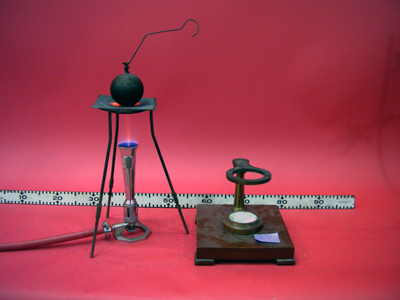
Description:
This demonstration has a ball and ring with stand. It demonstrates the thermal expansion of the material by heating the ball.
Equipment |
Location |
ID Number |
|
|
|
A ring with stand and a ball with hanger |
4A30.20 |
|
Burner with an iron ring tripod and wire net screen |
location |
NA |
An iron ring tripod and a screen |
location |
NA |
Safety grove and glasses |
location |
NA |
Rooms 2103, 2241, (and 2223 upon request) |
|
Important Setup Notes:
This demonstration requires a supply of methane gas usually provided by the red and white gas carts found in rooms 2103, 2241, (and 2223 upon request).
Setup and Procedure:
To light the burner, connect the attached gas hose to the gas out (red panel) on the red and white gas cart.
- Open the gas valve.
- Light a match and bring it near the top of the burner.
- The flame will ignite the gas. Adjust the flame height accordingly by adjusting the valve.
- Show that the ball can get through the ring.
- Put the lit burner beneath the tall ring stand with the screen on the top.
- Lower the ball onto the screen using the attached hook. It will take about a minute for the ball to heat up enough to not fit through the ring
- Take the ball off the stand and try to lower the ball through the ring.
If the ball fits through the ring, repeat steps 7 & 8. Otherwise, let the ball rest on the ring. As it cools, it will eventually shrink enough to drop through the ring.
Cautions, Warnings, or Safety Concerns:
- Always use the gloves and safety glasses throughout this demonstration.
- Beware of the heated plate - contact with skin could cause severe burns!
Discussion:
When the ball is heated, its dimensions increase while maintaining their relative proportions. Heating causes the molecular bonds to lengthen, which causes the material to expand. This is considered a 2D expansion since the quantity of importance for the ball to fit through the ring is the cross sectional area. The expansion can be described by ΔA/A = αA*ΔT = αL2*ΔT where A is the area at temperature Ti, ΔA is the change in area when the material is at temperature Tf, ΔT is Tf - Ti, and α is the coefficient of thermal expansion which depends on the material. See references below for more information.
|
|
|
|
|
|
Videos:
References:
